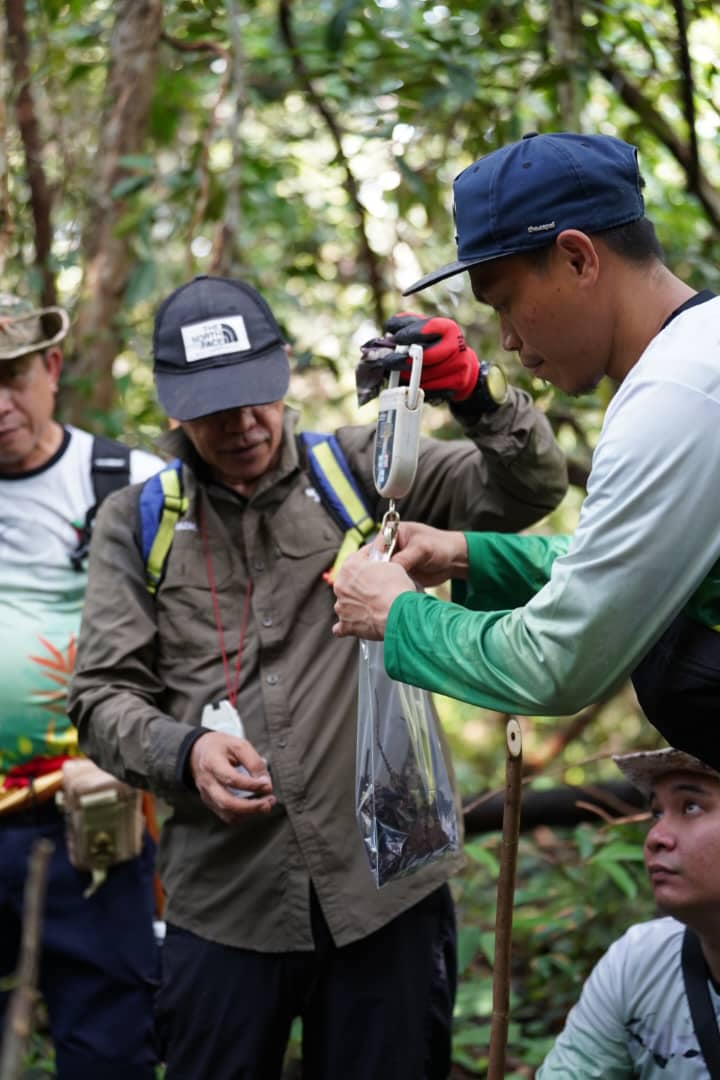From 23 to 26 January 2024, a refresher course was organised by Forest Department Sarawak (FDS) through its Planning and Management Division in Sibu, focusing on the skills and techniques of forest resource inventory.
A total of 50 participants comprising officers from the Planning and Management Division at the department’s headquarters and all Regional Forest Offices in Sarawak, as well as a team of project consultants from Forest Research Institute Malaysia (FRIM), attended the course, which took place as part of the third phase of Projek Inventori Sumber Hutan Sarawak (ISH) di Kawasan Hutan Simpan Kekal (HSK) di Seluruh Sarawak.

It aimed to strengthen the capabilities of FDS staff who are involved in data collection work, and provide comprehensive initial exposure to those who are newly assigned to the forest resource inventory project.
The course covered topics including introductions to forest inventory, forest species identification and low- and high-level plant identification. Participants also learned field data collection techniques, processing, and their practical application.
“Courses like this are very important because at the Regional Forest Office level, there is a need for more people who are able to identify forest species accurately with proper field data collection techniques,” FDS said in a Facebook post, adding that given the participants’ positive response such courses would be held again in the future.
What is Forest Inventory?
Since Europe began gathering information on its forests in an orderly manner in the late 18th century, the idea of recording forest resources that are available – more so because forests now only account for 31 per cent of land area on Earth – has become a global effort.
The Food and Agriculture Organisation of the United Nations (FAO) defines forest inventory as “the systematic collection of data on the forestry resources within a given area”.

It is an integral aspect of sustainable forest management because it enables the assessment of the latest status on forests and their resources, and sets the foundation for further analysis and planning.
Essentially, FAO suggests following these steps to ensure effective forest inventory operations, taking into consideration the purpose, targeted audience, and scale:
- Define the inventory objectives and information desired
- Develop sampling design and methods
- Collect data (field surveys, remote sensing data analysis, etc.)
- Analyse and publish data results
Forest inventories in the past concentrated on determining the availability of timber. Today, they are commonly designed to be more multi-purpose, with various input from diverse areas of expertise such as sampling theory, surveying, modelling, mensuration, information technology, remote sensing and social science to evaluate the numerous functions of trees and forests.

In Malaysia, forest inventory is utilised as a long-term approach in its national forest monitoring system. It has been carried out in the country over the past many decades with wide-ranging objectives and methods.
FAO played an instrumental role in implementing this inventory in Sarawak between 1969 to 1972 under the Forestry and Forest Industries Development Project, where it had managed to register eight industrial units of mixed dipterocarp forest encompassing 1.2 million hectares.
Since then, FDS has been performing forest resource inventories on Sarawak’s diversified forested areas every year. For example, as part of the Heart of Borneo (HoB) initiative, the department has published its findings on the forest resource inventory that was carried out in the HoB Sarawak area in two phases from 2016 to 2020.
Covering around 2.7 million hectares, among the forests inventoried in the project were mixed dipterocarps forests (consisting of lowland dipterocarp, hill dipterocarp, upper hill dipterocarp forests); montane forest; mangrove forest; peat swamp forest; and kerangas/heath forest (that includes Melaleuca forest).
Reference:
Brack, C. (2000, June). History of inventory. https://fennerschool-associated.anu.edu.au/mensuration/history.htm
Forest Department Sarawak. (2024, February 1). Jabatan Hutan Sarawak melalui Projek Inventori Sumber Hutan Sarawak (ISH) di Kawasan Hutan Simpan Kekal (HSK) di Seluruh Sarawak [Image attached] [Status update]. Facebook. https://www.facebook.com/ForestDepartmentSarawak/posts/pfbid037EgA4pKARG3WbjRdbsZcBru1iRZfZ89RSw7GTUcoNQewp1cyPLnY1oF7frSNZyFTl
Forest Department Sarawak. (2021). Forest Resource Inventory in the Heart of Borneo (HoB) Sarawak (2016-2020). [Pdf]. https://forestry.sarawak.gov.my/web/attachment/show/?docid=N0xnRHUrc216NTZNWmcxVmVhbDFGQT09OjoHj55VoprDidB5sc9jiioL
Forest Inventory. (n.d.). Food and Agriculture Organisation of the United Nations. https://www.fao.org/sustainable-forest-management/toolbox/modules/forest-inventory/basic-knowledge/en/
National Forest Monitoring System. (n.d.). Ministry of Natural Resources, Environment & Climate Change. https://redd.nrecc.gov.my/wp-content/uploads/2021/10/National_Forest_Monitoring_System.pdf






